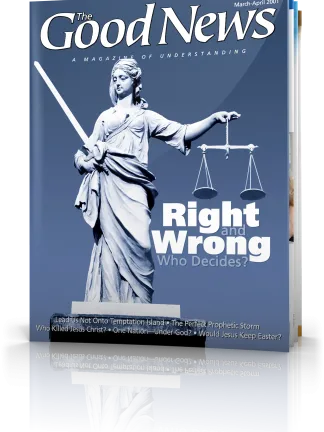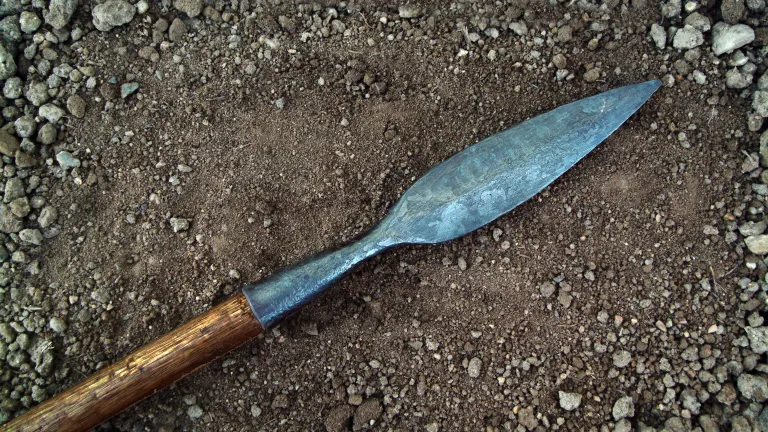Lessons From Two Resurrections
John's Gospel details two instances in which individuals were resurrected from the dead. The first astonished its witnesses, but the second transformed Jesus' disciples' lives, giving them power and conviction to face trials, persecution and even martyrdom for an astounding truth.
Lazarus lived with his two sisters in the little village of Bethany. They were close friends of Jesus of Nazareth, who often stayed with them when He visited Jerusalem.
But one day Lazarus became ill. "Now a certain man was sick, Lazarus of Bethany, the town of Mary and her sister Martha ... Therefore the sisters sent to [Jesus], saying, 'Lord, behold, he whom You love is sick'" (John 11:1-3).
John describes this family as close, filled with love and peace. No doubt Christ enjoyed visiting these friends' home and relaxing after arduous journeys. Notice the sisters didn't even ask for Him to come. They knew that once He heard of Lazarus' illness He would journey to see His sick friend.
But Jesus didn't do what they expected. He deliberately waited (verses 6-7).
In the meantime, the illness claimed Lazarus' life. By the time Jesus arrived Lazarus had been dead at least four days. Martha, in her anguish, met Christ as He arrived. "Lord, if You had been here, my brother would not have died." Christ responded to her in her grief by urging her to have faith and believe in Him. He even told her, "Your brother will rise again" (verses 21, 23). Martha responded that she knew Lazarus would "rise again in the resurrection at the last day" (verse 24). She was aware of God's promises of a resurrection at the end of this age. (To better understand the promised resurrections, request your free booklets What Happens After Death? and Heaven and Hell: What Does the Bible Really Teach?)
However, she did not understand that God would use her brother's death to glorify His Son, Jesus the Messiah. She did not believe she would ever see her brother again in this life.
Jesus again offered her encouragement. "I am the resurrection and the life" He told her. "He who believes in Me, though he may die, he shall live. And whoever lives and believes in Me shall never die. Do you believe this?" (verses 25-26).
Martha responded positively to some of what Jesus said: "Yes, Lord, I believe that You are the Christ, the Son of God, who is to come into the world" (verse 27). She may have been unsure about the rest of His meaning or what He was driving at. Regardless, she summoned her sister Mary, who was still mourning in their house.
When Mary came, "Jesus saw her weeping, and the Jews who came with her weeping." He "groaned in the spirit and was troubled. And He said, 'Where have you laid him?'" (verses 33-34).
As was a common practice at the time, Lazarus' friends and family interred him in a cave. Then they covered its entrance with a large rock to keep out predators. Christ told those present to remove the stone that covered the mouth of the cave. Martha objected that Lazarus' body would have already begun to decay.
Jesus persisted, so "they took away the stone from the place where the dead man was lying" (verse 41). After a short prayer to His Father, Christ, in a loud voice, shouted, "Lazarus, come forth!" (verse 43).
From within the dark cave came the sounds of movement, and shortly the figure of a man struggling to walk appeared at the entrance. He was struggling because his body was still wrapped in the strips of linen cloths in which he had been interred!
"And he who had died came out bound hand and foot with graveclothes, and his face was wrapped with a cloth. Jesus said to them, 'Loose him, and let him go.' Then many of the Jews who had come to Mary, and had seen the things Jesus did, believed in Him" (verses 44-45).
Word of this remarkable event quickly reached the religious authorities in Jerusalem. Perceiving Jesus to be a threat to their positions and the stability of the Roman-dominated province, they plotted to do away with Him. Little did anyone realize the stage was being set for another death and resurrection, one far more significant than that of Lazarus.
An innocent man crucified
Around 3 o'clock on the afternoon of Passover day, the demands of the hostile crowd were fulfilled. Shortly after Jesus breathed His last, Joseph of Arimathea and Nicodemus, two less-well-known followers of Jesus, quickly went into action. Both men believed Jesus' teachings, yet they kept their belief secret out of fear of what their fellow Jews might do to them.
Perhaps they were ashamed of their earlier reticence. But now they showed the courage to step forward and claim Jesus' body and begin preparing it for proper, but hasty, entombment. It was Joseph of Arimathea who went to Pilate and asked for Christ's body and offered his own new tomb as a place of burial. Nicodemus assisted Joseph and contributed a vast amount of costly spices for His burial.
Since it was already around 3 o'clock in the afternoon, there was not much time before the "high day" (John 19:31), one of seven biblical annual sabbaths (Leviticus 23), began. They had much to do before sunset, at which time they would cease work to honor that Sabbath.
"Then they took the body of Jesus, and bound it in strips of linen with the spices, as the custom of the Jews is to bury. Now in the place where He was crucified there was a garden, and in the garden a new tomb in which no one had yet been laid. So there they laid Jesus, because of the Jews' Preparation Day [for the Sabbath], for the tomb was nearby" (John 19:40-42).
Jewish burial practices
Because of the hot climate and reli-gious customs, the Jews of that day would bury their dead quickly. They practiced neither cremation nor the Egyptian custom of embalming.
The poor would simply bury their dead in the ground, covering the grave with earth and stones. Others would use caves as a place of entombment, as happened with Lazarus. Those who could afford to would carve tombs in the sides of some of the many hills and mountains of the area. Such tombs would typically have several shelves carved in the stone on which the bodies of family members would be laid.
A body would normally be washed and then wrapped in a clean linen cloth or strips of cloth, similar to the way Egyptians wrapped their mummies. Families that were better off financially would put perfumes, ointment and spices on the body and between the wrappings of cloth. In some cases the spices and ointments would be thick enough to cause the outer cloths in time to harden somewhat like a cocoon.
Myrrh is specifically mentioned as used in the preparation of Christ's body. Myrrh is a pleasant-smelling resinous substance from several types of trees in Arabia and North Africa. Usually a separate piece of cloth would be wrapped around the head of the deceased. If the death occurred just before a Sabbath, it was especially important that the body be taken to its resting place before the Sabbath began. The dead were not to be buried on the Sabbath.
Some of the women who followed Jesus also made plans to buy spices for the preparation of His body. They took note of His burial place and went to their homes to rest on the Sabbath. Again, this Sabbath was a high day (John 19:31), in this case the first day of Unleavened Bread, which fell on a Thursday that year. When the annual Sabbath was over, on the next day, Friday, they went into the city to purchase the spices and oils.
"And Mary Magdalene and Mary the mother of Joses observed where He was laid. Now when the Sabbath was past, Mary Magdalene, Mary the mother of James, and Salome bought spices, that they might come and anoint Him" (Mark 15:47; 16:1).
The women spent the remaining time on this Friday preparing the spices for the anointing of Christ's body. "Then they returned and prepared spices and fragrant oils. And they rested on the Sabbath according to the commandment" (Luke 23:56).
Notice that Mark mentions the women buying the spices after the Sabbath, and Luke states they prepared the spices before the Sabbath. There is no contradiction when we realize that two Sabbaths are involved in this three-day period. After resting on the weekly Sabbath, which ended Saturday at sunset, they went to the tomb the next morning to be there at first light. (To better understand the timing of Christ's crucifixion and resurrection-which were not on Friday and Sunday-request our free booklet Holidays or Holy Days: Does It Matter Which Days We Keep?)
An astounding discovery
When the women arrived at the tomb, they discovered the stone cover had been rolled back and the tomb was empty! They rushed to inform the other disciples. When they returned and saw the evidence of what had happened, they realized God had indeed raised Jesus Christ to a new life exactly as He had said would happen.
But what was the evidence? The most astounding discovery was not the empty tomb, nor the announcement of an angelic being proclaiming that "He is not here, He has risen!" It was something else. Among the Gospel writers, only John records what that was. Let's read it in John 20.
"Early on the first day of the week, while it was still dark, Mary of Magdala came to the tomb. She saw that the stone had been moved away from the entrance, and ran to Simon Peter, and the other disciple [John], the one whom Jesus loved. 'They have taken the Lord out of the tomb,' she said, 'and we do not know where they have laid him.'
"So Peter and the other disciple set out and made their way to the tomb. They ran together, but the other disciple ran faster than Peter and reached the tomb first. He peered in and saw the linen wrappings lying there, but he did not enter. Then Simon Peter caught up with him and went into the tomb. He saw the linen wrappings lying there, and the napkin which had been round His head, not with the wrappings, but rolled up in a place by itself. Then the disciple who had reached the tomb first also went in, and he saw and believed" (verses 1-8, Revised English Bible).
What did the disciples see that made them believe? It wasn't simply an empty tomb. If the body had been stolen, as Mary of Magdala had assumed, all they would have seen was an empty tomb.
But there was more. Christ had told them several times He would die and rise again, but that prophecy hadn't sunk in. What Peter and John saw instantly convinced them not only that His body had not been stolen, but that God the Father had raised Jesus to glory and immortality! (Acts 3:13-15).
Powerful evidence left behind
Christ's wrapped body had lain on a rock shelf in the tomb. Yards of linen cloths had been wrapped around His body. Spices and thick myrrh were placed inside those wrappings, essentially pasting them together.
What Peter and John saw as they peered into the dimness of the man-made cave was a neat, collapsed cloth form. If thieves had removed Jesus' body, if grave robbers had been at work, why should they leave these wrappings?
No tomb robber would have taken the time to unwrap the body and leave the burial cloths there, especially since they would have been in danger of being discovered by the guards the Roman authorities had posted there to prevent that very thing from happening (Matthew 27:62-66; 28:11-15).
But there was more. The cloths were not scattered; they were still wrapped. This resurrection was not like Lazarus', in which he was restored to live a few more years and would eventually die again. This was the resurrection of a spirit body (see 1 Corinthians 15:44).
What John saw made a profound impression on him. The grave clothes were not disheveled and disarranged, as would have been the case if someone had removed them or someone had struggled to free himself from the wrappings. The original Greek wording means they were lying there still in their folds, the clothes for the body where the body had been and the "napkin," a smaller, separate piece of cloth, where the head had lain.
The whole point of John's description is that the grave clothes did not look as if they had been discarded or taken off. They were lying in their regular folds as if the body of Jesus had simply evaporated out of them.
The sight instantly penetrated John's mind. He realized what had happened-and he believed. It was not what Jesus had said so often that convinced John that Christ had risen. It was what he saw with his own eyes!
John's convincing details
Notice this comment from Vine's Expository Dictionary of Old and New Testament Words about Jesus' head covering being "wrapped together in a place by itself" there in the tomb (John 20:7, King James Version): "... 'Wrapped together' might suggest that this cloth had been 'rolled' or wrapped up and put in a certain part of the tomb at the Lord's resurrection, whereas, as with the body wrappings, the head cloth was lying as it had been 'rolled' round His head, an evidence, to those who looked into the tomb, of the fact of His resurrection without any disturbance of the wrappings either by friend or foe or when the change took place" (W.E. Vine, 1985, "Roll"). Jesus' glorified body had passed right through the cloth!
The International Standard Bible Encyclopedia, in its article "Resurrection of Jesus Christ," states: "Significantly, the grave clothes were undisturbed ... Long ago, Chrysostom pointed out that the grave robbers would not have stolen the body naked because of time restraints and other difficulties ('it was buried with much myrrh, which glues linen to the body not less firmly than lead' [Hom. (homily) 85 on Jn. 4]). The Gospels describe an orderly scene, not one of confusion that would have resulted had the grave clothes been torn from the body. That something extraordinary had taken place is shown by the fact that the beloved disciple 'saw and believed' ..." (1988, Vol. 4, p. 151).
In a footnote on John 20:7, the Companion Bible explains that John's original wording "implies that the cloth had been folded round the head as a turban is folded, and that it lay still in the form of a turban. The linen clothes also lay exactly as they were when swathed round the body. The Lord had passed out of them, not needing as Lazarus ([John] 11:44), to be loosed. It was this sight that convinced John (v. 8)."
We can share in Christ's resurrection
The apostle John recorded significant and crucial differences in these two resurrections. In the first, the stone covering of the tomb was removed so Lazarus could get out. The stone covering of the other was rolled back, not so Jesus could get out, but so the disciples could see inside and then draw the inescapable conclusion that Jesus had already gotten out!
Of the two who were entombed, the first had to have others remove the wrappings so he could walk about. The other did not, for He had passed through His wrappings in a body of spirit.
Later John made it clear that Christ's true followers will likewise be resurrected, that they will be like Him in a glorious resurrection to immortal spirit life: "Behold what manner of love the Father has bestowed on us, that we should be called children of God! ... Beloved, now we are children of God; and it has not yet been revealed what we shall be, but we know that when He is revealed, we shall be like Him, for we shall see Him as He is. And everyone who has this hope in Him purifies himself, just as He is pure" (1 John 3:1-3). GN




